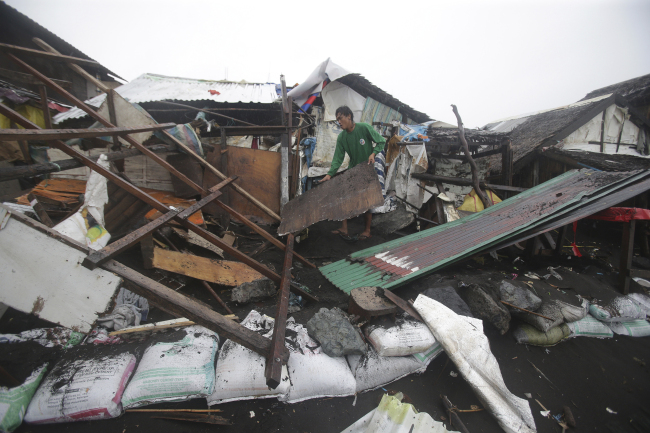Major storm moves toward Manila
Hagupit kills at least 21, destroys thousands of homes on remote islands
By Korea HeraldPublished : Dec. 8, 2014 - 21:20
MANILA (AFP) ― Millions of people in the Philippine capital hunkered down Monday as a major storm churned toward the megacity, after killing at least 21 people and destroying thousands of homes on remote islands.
However Hagupit weakened from a typhoon as it moved slowly across the central Philippines, fuelling cautious optimism the disaster-weary nation may avoid another calamity involving hundreds of deaths.
In Metro Manila, a sprawling coastal megalopolis of 12 million people that regularly endures deadly flooding, well-drilled evacuation efforts went into full swing as forecasters warned of heavy rain from dusk.
“We are on 24-hour alert for floods and storm surges ... it’s the flooding that we are worried about,” Joseph Estrada, mayor of Manila, the original city of two million within Metro Manila, said.
However Hagupit weakened from a typhoon as it moved slowly across the central Philippines, fuelling cautious optimism the disaster-weary nation may avoid another calamity involving hundreds of deaths.
In Metro Manila, a sprawling coastal megalopolis of 12 million people that regularly endures deadly flooding, well-drilled evacuation efforts went into full swing as forecasters warned of heavy rain from dusk.
“We are on 24-hour alert for floods and storm surges ... it’s the flooding that we are worried about,” Joseph Estrada, mayor of Manila, the original city of two million within Metro Manila, said.

Thousands of people, mostly the city’s poorest residents who live in shanty homes along the coast and riverbanks, crammed into schools and other government evacuation centers across Metro Manila on Monday.
Schools were suspended, the stock market was closed, many office and government workers were told to stay at home, and dozens of commercial flights were cancelled.
The preparations were part of a massive effort led by President Benigno Aquino to ensure minimum deaths, after 7,350 people died when Super Typhoon Haiyan devastated large parts of the central Philippines in November last year.
Millions of people in communities that were directly in the path of Hagupit over the weekend were sent to evacuation centers or ordered to remain in their homes.
The storm, the strongest to hit the Philippines this year with wind gusts of 210 kilometers an hour when it made landfall, caused massive destruction in remote farming and fishing towns.
Thousands of homes were destroyed, power lines were torn down, landslides choked roads, and flood waters up to one story high flowed through some towns.
Hagupit claimed at least 21 lives, with 18 of those deaths on Samar Island where the storm made landfall, Philippine Red Cross secretary-general Gwendolyn Pang said.
Sixteen people died in Borongan, one of the main cities along Samar’s east coast that faces the Pacific Ocean and about 50 kilometers south of where Hagupit struck, according to Pang.
She said it was impossible to say whether the death toll would climb, with full damage assessments from some areas that were hit yet to come in and the storm still travelling across the country.
Before the reports of the deaths, presidential spokeswoman Abigail Valte and other government officials expressed optimism that the intense focus on evacuations had saved many lives.
“Preemptive evacuation was carried out and warnings by authorities were taken seriously,” Valte said.
In Tacloban, a city of 220,000 people that was one of the worst-hit during Haiyan, authorities said there were no casualties over the weekend despite fierce winds that destroyed homes.
“There is a collective sigh of relief ... we were better prepared after Yolanda,” Tacloban vice mayor Jerry Yaokasin said Sunday, referring to Haiyan by its Philippine name.
However just as crucially, Hagupit’s winds were significantly weaker than Haiyan, which was the strongest storm ever recorded on land. There was also no repeat of Haiyan‘s tsunami-like storm surges.
Hagupit’s sustained winds dropped to 140 kilometers an hour on Sunday, then continued to weaken after leaving the eastern Philippine islands and passing over the Sibuyan Sea southeast of Manila.
Its winds were down to 110 kilometers an hour on Monday and were expected to weaken further as it passed just south of the capital in the evening, according to local weather agency Pagasa.
However Pagasa said the winds were still capable of doing major damage to homes, and heavy rains were expected within Hagupit’s 450-kilometre-wide weather front.
The Philippines endures about 20 major storms a year, many of them deadly.
But scientists say the storms are becoming more violent and unpredictable because of climate change.
Greenpeace International director Kumi Naidoo called on United Nations negotiators currently meeting in Peru to take note of Hagupit and act with more urgency to hammer out a world pact on global warming.
“Nature does not negotiate. We actually have to wake up and smell the coffee,” Naidoo, who is in the Philippines to “bear witness” to Hagupit, said.
“We need to understand that we are running out of time.”
-
Articles by Korea Herald



![[Herald Interview] 'Amid aging population, Korea to invite more young professionals from overseas'](http://res.heraldm.com/phpwas/restmb_idxmake.php?idx=644&simg=/content/image/2024/04/24/20240424050844_0.jpg&u=20240424200058)


![[Pressure points] Leggings in public: Fashion statement or social faux pas?](http://res.heraldm.com/phpwas/restmb_idxmake.php?idx=644&simg=/content/image/2024/04/23/20240423050669_0.jpg&u=)












